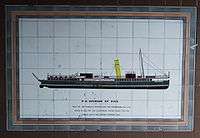PS Duchess of Fife (1903)
PS Duchess of Fife was a paddle steamer built in 1903 for the Caledonian Steam Packet Company. She spent most of her career serving passenger routes in the Firth of Clyde and was requisitioned for use as a minesweeper during both World Wars. In 1940 she took part in the Dunkirk evacuation, rescuing a total of 1,633 allied troops.
 A mosaic of the Duchess of Fife in a Greenock underpass | |
| History | |
|---|---|
| Name: |
|
| Owner: | |
| Operator: |
|
| Builder: | |
| Yard number: | 432 |
| Launched: | 9 May 1903 |
| Honours and awards: | Dunkirk 1940 |
| Fate: | Scrapped, 15 September 1953 |
| General characteristics | |
| Type: | Paddle steamer |
| Tonnage: | 336 GT |
| Length: | 213.3 feet (65.0 m) |
| Propulsion: | Triple expansion diagonal |
| Speed: | 17 knots |
She was sold for scrapping in September 1953 after 50 years of service.
Construction
Duchess of Fife was built by the Fairfield Shipbuilding and Engineering Company in Govan, Glasgow, as Yard Number 432 and was launched on 9 May 1903.[1] The design of her machinery was similar to that of her sister ship in the Caledonian Steam Packet Company, PS Duchess of Montrose.[2]
Service history
Duchess of Fife began her passenger service on the Gourock to Dunoon and Rothesay routes.[2] In May 1916 she was requisitioned by the Admiralty and converted to a minesweeper for the remainder of World War I with her name shortened to HMS Duchess, and was allocated the pendant number PP533, where she served in the North Sea.[3] She was returned to her owner in April 1919 and from 1937 she undertook sailings from Wemyss Bay to Millport and Kilchattan Bay.[2]
She was requisitioned once again in 1939 upon the outbreak of World War II, this time retaining her full name as HMS Duchess of Fife, pendant number J115.[4] She was part of the 12th Minesweeping Flotilla, based at Harwich.
Duchess of Fife took part in "Operation Dynamo", the Dunkirk evacuation, while under the command of Temporary Lieutenant J N Anderson of the Royal Naval Reserve.[5] From 28 May, she undertook four crossings between Dunkirk and Ramsgate rescuing a total of 1,633 allied troops.[6] Her final crossing was on 3 June with 300 French troops.[5] She was later awarded a Royal Navy battle honour for her part in the operation.[7]
She was refurbished by James Lamont & Co, Greenock, in 1945 and returned to civilian service.[1] The last sailing of Duchess of Fife was on 6 June 1953, and she was sold for scrapping in September 1953[2] to Smith & Houston Ltd, Port Glasgow.[1]
References
- "Paddle Steamer DUCHESS OF FIFE". The Caledonian Maritime Research Trust. Retrieved 30 September 2017.
- Deayton, Alistair (2014) The Caledonian Steam Packet Company: An Illustrated History, Amberley Publishing: Stroud, UK ISBN 978-1-4456-3920-8
- "Minesweepers & Trawlers – World War 1". Harwich & Dovercourt – A time gone by. Retrieved 30 September 2017.
- "Duchess 1903 HMS – Auxiliary Paddle Minesweeper". ClydeMaritime. Retrieved 30 September 2017.
- Gardner, W. J. R. (2000), The Evacuation from Dunkirk: 'Operation Dynamo', 26 May – 4 June 1940, Frank Class Publishers: London, UK. ISBN 0-7146-8150-4
- Winser, John de S. (1999). B.E.F. Ships before, at and after Dunkirk, World Ship Society: Gravesend, UK. ISBN 0-905617-91-6
- Warlow, Ben, Lt. Cdr., Royal Navy (2004) Battle Honours of the Royal Navy, Maritime Books: Liskeard, UK; ISBN 1-904459-05-6